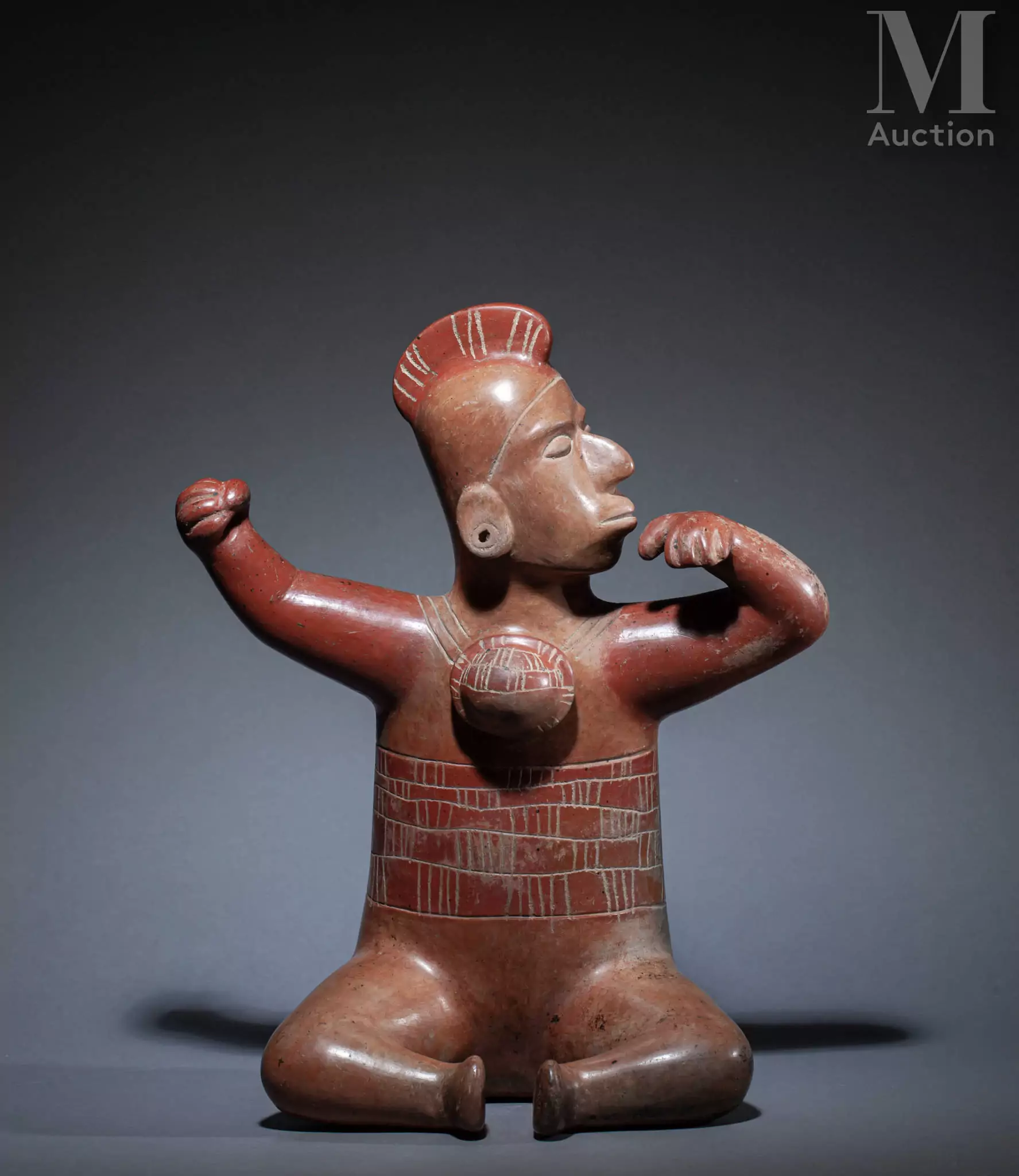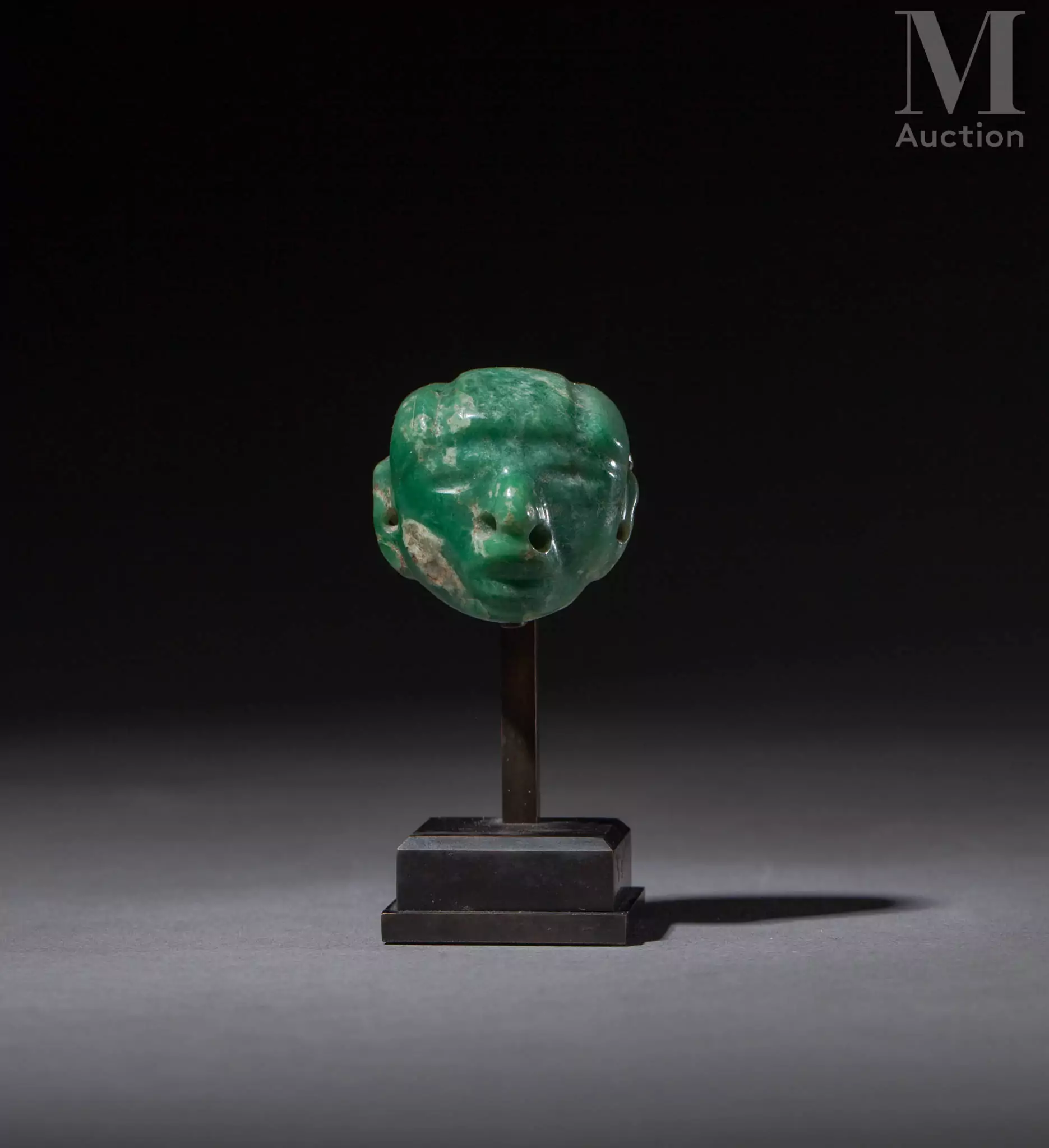*Totem
featuring a standing figure.
Standing frontally on his base, our guardian adopts the frozen attitude typical of Chimú statuary. This conventional hieratic stance is accentuated by the angular style of the facial and body features, also characteristic of ancient Peruvian representations.
At first glance, he is holding what could be a flute known as a QUENA, or perhaps a KÉRO, a vessel used in rituals and ceremonies. Since the schematization of the object makes it impossible to decide with certainty, both hypotheses are generally accepted. Wearing a high, flat-topped, quadrangular cap, the head is particularly important. If the overall harmony of this sculpture is apparent, the proportions of this man clearly favor this part of the body, which alone measures the equivalent of the bust and legs. On the forehead, hidden by this imposing headgear, two horizontal projections identify a short fringe. The face forms a perfect oval, and its features are reduced to essentials, with no naturalistic intent. The outline of the almond-shaped eyes is simply engraved. Slightly asymmetrical, the eyes are set high under the forehead and close to the nose, accentuating the surface of the cheeks and temples. Wide and protruding, the nose is the only relief that really enlivens this impassive face. Two slender, oblique lines run from its base. Descending to the jawline, they visually form a triangle into which a discreet mouth, barely ajar, seems to blow. The ears are set fairly low, on the same axis as the mouth, and consist of two half-moon-shaped protrusions.
Our man's neck is entirely taken up by a wide, tight collar, resembling a ruff, which separates the head from the rest of the body. This is followed by angular shoulders and rectilinear arms attached to the torso. The biceps have not been emphasized, but the forearms, folded obliquely over the torso, stand out, as do the clasped hands and the cylindrical object they hold upright in line with the body. The fingers are long and broad, symmetrically arranged on either side of the hand joint, and their tips are clearly truncated.
Wood
Chimu, Peru, 1100 - 1470 A.D.
54 x 15 cm
Provenance :
- Former collection of Docteur Guy Dulon, Paris, since 1968
- Collection of M. Jean Benoit (sculptor close to André Breton), Paris
Comparative works :
- Totem Chimu, MET, Metropolitan Museum of Art, New York
- Totem Chimu, Brooklyn Museum, New York
This magnificent figure is a masterpiece of Chimú art. This great people ruled the northern coast of Peru from around the 10th century until the Inca conquest (1470). The epicenter of their kingdom was Chan-Chan, a huge fortified city built in adobe1, the largest settlement in South America at the time.
Chimú craftsmen were particularly fond of wood, with which they produced many precious objects. While most of these pieces have now disappeared, the dry climate of Peru's coastal desert miraculously saved some of their works, now preserved in major museums and private collections.
The large size of this sculpture and the pedestal on which it rests indicate that it is a totem. This type of statue was generally installed around the residences and tombs of the Chimú elite, as well as at the entrance to sacred enclosures. Carved on a stake or a long pole (not shown here), they were planted deep in the sandy soil and, like impressive sentinels, watched over the places occupied by the powerful caste and their graves.
Many wooden sculptures attributed to pre-Inca cultures adopt the posture of our figure, hands clasped on his belly, holding a kero, a beaker containing ritual beverages such as chicha, a fermented corn alcohol consumed since the dawn of time. The presentation of the kero thus appears to be a central theme in ancient Peruvian iconography, and could be a key moment in religious and political events.
It is also possible that the object held by our figure is a typical Andean flute, known as a quena. The origin of this instrument goes back a long way. One example has been found in Argentina, dating back to 2130 BC. In Peru, it is found with certainty in the remains of most pre-Incan cultures (Chavin, Nazca, Lima, Moche, Chincha, Chancay, etc.) and, of course, among the Incas themselves.
This instrument is not confined to any one country; it has spread throughout South America, from Argentina to Colombia, and goes by different names in different regions: quena, kena, kehna, qina, kkhéna, etc. This ancestral flute is traditionally made of reed, bone, precious wood and, more rarely, stone, terracotta or calabash. Initially rudimentary, it was perfected by the various Andean cultures, and over time its design became more regular and standardized.
Seemingly simple, the quena consists of a tube with a bevelled notch at one end to form the mouthpiece, and a number of holes to vary the sound. In pre-Columbian times, it was used in ceremonies, accompanied by percussion instruments.




